CHARGING SYSTEM > ON-VEHICLE INSPECTION |
for Preparation Click here
| 1. CHECK BATTERY CONDITION |
- NOTICE:
- If the battery is weak or if the engine is difficult to start, perform the following procedures.
Check the battery for damage and deformation. If severe damage, deformation or leakage is found, replace the battery.
Check the electrolyte quantity of each cell.
For maintenance-free batteries:
- If the electrolyte quantity is below the lower line, replace the battery.
If the electrolyte quantity is above the lower line, check the battery voltage when cranking the engine.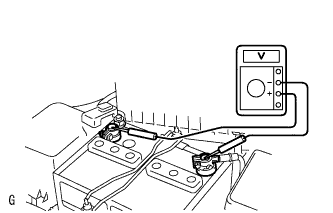
- If the voltage is less than 9.6 V, recharge or replace the battery.
- HINT:
- Before checking the battery voltage, turn off all the electrical systems (headlight, blower motor, rear defogger, etc.).
- If the electrolyte quantity is below the lower line, replace the battery.
For non-maintenance-free batteries:
If the electrolyte quantity is below the lower line, add distilled water to each cell. Then, recharge the battery and check the electrolyte's specific gravity.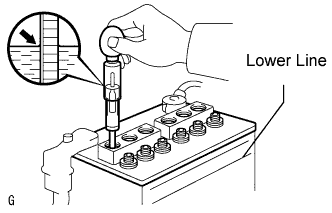
- Standard specific gravity:
- 1.25 to 1.29 at 20°C (68°F)
- HINT:
- Before checking the battery voltage, turn off all the electrical systems (headlight, blower motor, rear defogger, etc.).
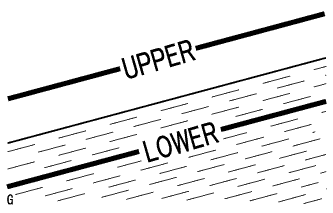 |
| 2. CHECK BATTERY TERMINAL AND FUSE |
Check that the battery terminals are not loose or corroded.
If the terminals are corroded, clean the terminals.
Measure the resistance of the H-fuse and fuses.
- Standard resistance:
- Below 1 Ω
| 3. CHECK DRIVE BELT |
Check the belt for wear, cracks or other signs of damage.
If any of the following defects is found, replace the drive belt.- The belt is cracked.
- The belt is worn out to the extent that the cords are exposed.
- The belt has chunks missing from the ribs.
- The belt is cracked.
 |
Check that the belt fits properly in the ribbed groves.
- HINT:
- Check with your hand to confirm that the belt has not slipped out of the groove on the bottom to the pulley. If it has slipped out, replace the drive belt. Install a new drive belt correctly.
 |
Check that the tensioner indicator mark is within range A shown in the illustration.
If the mark is not within range A, replace the drive belt.
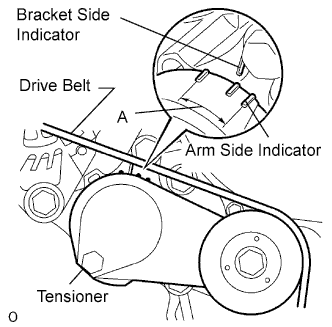 |
| 4. VISUALLY CHECK GENERATOR WIRING |
Check that the wiring is in good condition.
| 5. LISTEN FOR ABNORMAL NOISES FROM GENERATOR |
Check that the generator does not emit any abnormal noise while the engine is running.
| 6. CHECK CHARGE WARNING LIGHT CIRCUIT |
Turn the ignition switch to ON. Check that the charge warning light turns on.
Start the engine and check that the light turns off.
If the light does not operate as specified, troubleshoot the charge warning light circuit.
| 7. CHECK CHARGING CIRCUIT WITHOUT LOAD |
Connect a voltmeter and ammeter to the charging circuit as follows.
- HINT:
- If a battery/generator tester is available, connect the tester to the charging circuit according to the manufacturer's instructions.
Disconnect the wire from terminal B of the generator and connect it to the negative (-) lead of the ammeter.
Connect the ammeter's positive (+) lead to terminal B of the generator.
Connect the voltmeter's positive (+) lead to the positive (+) terminal of the battery.
Ground the voltmeter's negative (-) lead.
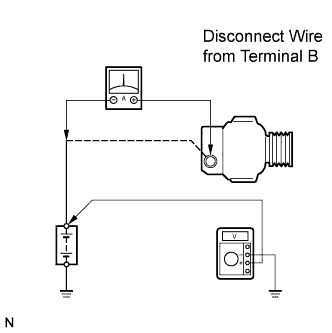 |
Check the charging circuit.
Keep the engine speed at 2000 rpm. Check the reading on the ammeter and voltmeter.
- Standard amperage:
- 10 A or less
- Standard voltage:
- 13.2 to 14.8 V
- HINT:
- If the battery is not fully charged, the ammeter reading will sometimes be higher than the standard amperage.
| 8. CHECK CHARGING CIRCUIT WITH LOAD |
With the engine running at 2000 rpm, turn on the high beam headlights and turn the heater blower switch to the HI position.
Check the reading on the ammeter.
- Standard amperage:
- 30 A or higher
- HINT:
- If the battery is fully charged, the charging circuit may not operate and the ammeter reading may be less than standard amperage. If this is case, add more electrical load (operate the wipers, rear window defogger, etc.) and check the reading on the ammeter again.
